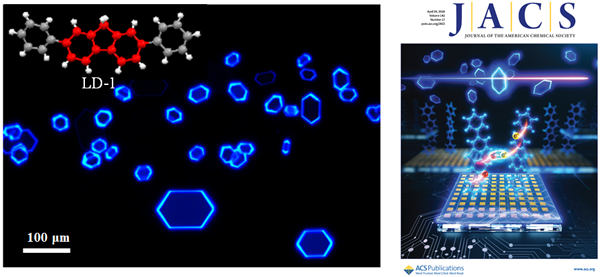Researchers achieve significant advance on the development of high mobility luminescent organic semiconductors
Researchers achieve significant advance on the development of high mobility luminescent organic semiconductors
Organic semiconducting molecules with high mobility and strong fluorescence are the basis of organic light-emitting transistors (OLETs), which demonstrate great promise for smart display technology and other related optoelectronic circuits. However, it remains a big challenge over the past decades.
Laboratory of Organic Solids from the Institute of Chemistry, Chinese Academy of Sciences, has been focusing on this challenge for several years, and demonstrated a strategy to balance charge transport and emission by integrating fluorogens with molecular packing (Nat. Commun. 2015, 6, 10032; J. Am. Chem. Soc. 2017, 139, 17261; Adv. Mater. 2019, 1903175; Angew. Chem. Int. Ed. 2020, doi: 10.1002/anie.202002644).
Recently, a research team led by Prof. DONG Huanli synthesize another novel organic molecule, 2,7-diphenyl-9H-fluorene (LD-1) from 2,7-dibromofluorene and phenyl-boronic acid using a palladium-catalyzed Suzuki coupling reaction with a high yield of 63%. The molecular design considerations are as following: (i) using fluorene with intrinsically superior emission as the building unit core, (ii) extending the π-conjugation of fluoresce at 2 and 7 positions with benzene ring groups, (iii) using the rotational carbon?carbon bond for modulation of the structure conjugation and stereo-conformation for integrated optoelectronic property. Results demonstrate that LD-1 compound has state-of-the-art integrated optoelectronic properties with a high mobility of 0.25 cm2 V-1 s-1 and high photoluminescence quantum yield of 60.3%. A typical herringbone molecular packing mode with a herringbone angle of 64.08° is characterized for LD-1 in single crystals where multiple strong C-H-π interactions (2.730-2.891 Angstrom) between neighboring molecules, which enables the efficient integration of optoelectronic property in the same molecule. Moreover, deep-blue and are also characterized for LD-1 with low threshold of Pth = 71 μJ cm-2 and Pth = 53 μJ cm-2 and high-quality factor (Q) of ~3100 and ~2700 at emission peaks of 390 and 410 nm, respectively. Organic light-emitting transistors based on LD-1 are for the first time demonstrated with obvious electroluminescent emission and gate tunable features. This work further enriches the high mobility emissive organic semiconductor systems and provides new avenue for other related research.
This work has been published in J. Am. Chem. Soc. 2020, 142, 6332-6339 and selected as the Front Cover.

The molecular structure and of LD-1 and the florescent image of its crystals (image by DONG Huanli)
Contact:
Prof. DONG Huanli
Institute of Chemistry, Chinese Academy of Sciences
E-mail:dhl522@iccas.ac.cn





